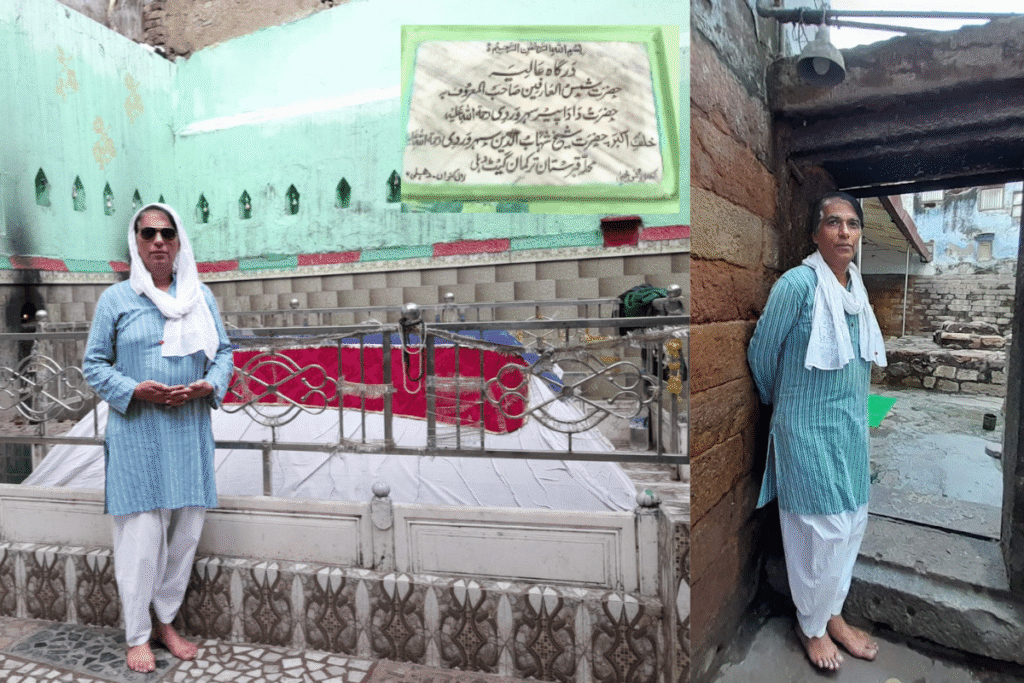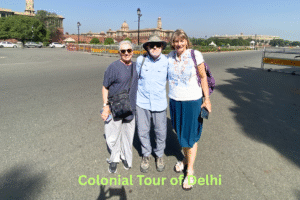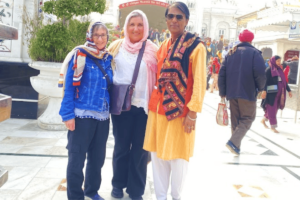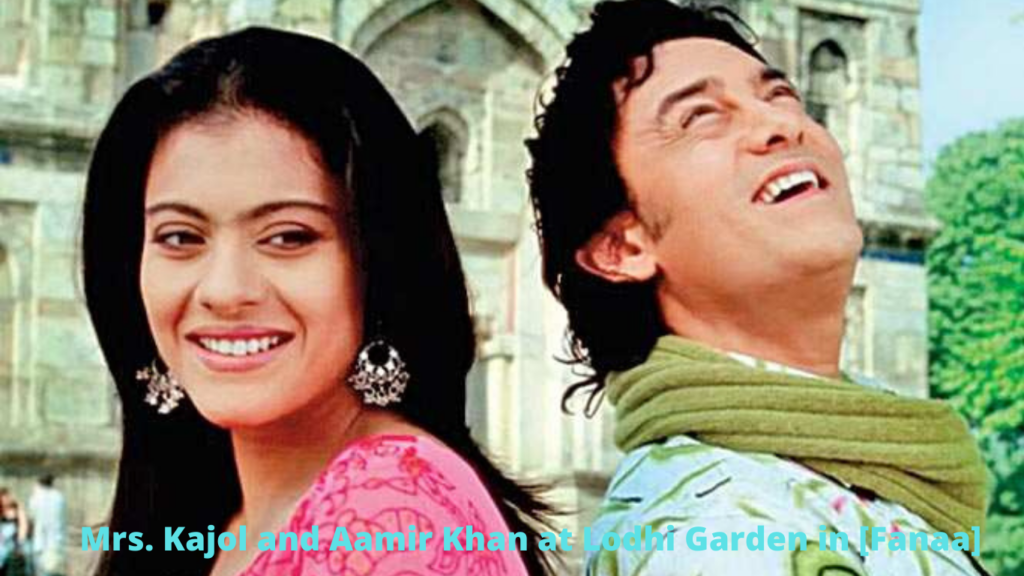I had always been curious about Turkman Gate Delhi history, so on a crisp winter afternoon, I joined Harry — my charming and almost ethereal Delhi tour guide — for a private heritage walk through Old Delhi. Perched in a rattling Tuk Tuk, we made our way to Ansari Marg, where an ancient, timeworn archway loomed ahead: Turkman Gate. Harry’s eyes sparkled with the excitement of a born storyteller as he began painting pictures of Shajahanabad — the Mughal capital built by Emperor Sha Jahan, the creator of the Taj Mahal. In 1627, to protect his magnificent city, the emperor raised mighty stone walls and crowned them with fourteen grand gates. This weathered arch before us was one of those silent guardians of history.

Tour Guide in Delhi – Your Best Tour Companion in Delhi
Turkman Gate Delhi History The Legacy of A Sufi Saint
In the heart of Shahjahanabad, where the whispers of history still echo through winding lanes, stands the majestic Turkman Gate — a silent guardian of centuries past. Long before the Mughal walls rose, he chose this wilderness by the Yamuna as his home, living simply and offering spiritual guidance. His followers, drawn by his compassion, came to see this place as sacred. This famous Shah e Turkman, who had arrived with the army of Sultan Qutbuddin Aibak around 13th-century. The romance of Turkman Gate Delhi history begins with Hazrat Shah Turkman Bayabani, a revered Sufi saint whose gentle spirit and selfless devotion captured the hearts of the people.
Locals lovingly called him “Bayabani” — the man of the wilderness — and their affection turned this humble spot into a site of pilgrimage. The saint’s story became woven into the very fabric of Turkman Gate Delhi history, inspiring awe among commoners and nobility alike. Later, Emperor Shahjahan, known for his reverence towards Sufi saints, honored Hazrat Shah Turkman by naming the gate after him. In a lasting tribute, the emperor also built a shrine within the walled city, ensuring that the saint’s blessings and memory would remain cherished for generations.
Architecture of Turkman Gate Delhi History – Form, Function, and Fortitude
Harry paused at the arch so I could take in its design, then traced the lines with his words. The gate follows a rectangular plan with two bays, combining a flat roof over one bay and a domed roof over the other—an elegant solution that balances strength with ceremony. Built primarily of red sandstone and Delhi quartzite, the surface still shows the rugged grain of local stone, softened by time and touch.
At its heart stands a single, double‑storey arched gateway, framed by flower medallions on either side—subtle ornament that lightens the otherwise martial façade. The heavy wooden doors once swung open from sunrise to sunset, regulating entry to the walled city. Above, a line of parapets (built with firing positions) provided cover for matchlocks and later firearms, while internal stairways led soldiers to the roof terraces for watch and defense.
Flanking the southern opening are semi‑octagonal bastions, projecting outward to widen the field of view and create overlapping fire—classic fortification logic rendered in Delhi stone. Every element here serves a purpose: to guard, guide, and withstand. Standing beneath it, with Harry’s gentle narration, the architecture stops being static masonry and becomes a living chapter in Turkman Gate Delhi history.
Turkman Gate Delhi History – An Emotional Story Of Razia Sultan’s Legacy

Harry took me to show the area near Turkman Gate, and his storytelling was so emotional that I felt completely transported back in time. As we stood in the shadow of this historic gateway, Harry began narrating the Turkman Gate Delhi history, painting vivid pictures of the past. I truly felt sorry for Razia Sultan — the courageous queen who dared to rule in a man’s world.
While listening, I imagined her dressed in a man’s outfit, with a turban tied firmly on her head, riding fearlessly through the streets of old Delhi. The thought stirred something deep inside me — admiration, sorrow, and wonder all at once. Strangely, my thoughts drifted to Harry himself. In his graceful manner and warm smile, I pictured him in elegant female attire, and he looked just as pretty in my mind as any royal princess from history.
That walk near Turkman Gate was not just about bricks and walls; it was about bravery, defiance, and the timeless connection between past and present. Harry didn’t just guide me — he made me feel history in my heart.
Old Delhi Heritage Walk- Street Food, Stories & The Magic of Old Delhi
Discovering Kalan Masjid – A Jewel of Turkman Gate Delhi History

As we wandered through the narrow, bustling streets, Harry’s eyes lit up as he pointed towards the striking green-and-white facade of Kalan Masjid. The afternoon light bounced off its freshly painted walls, giving this centuries-old structure a glow that seemed to transcend time. We climbed up to its high platform, and sitting along the side walls, Harry began another enchanting chapter of Turkman Gate Delhi history.
Kalan Masjid, once celebrated as one of the tallest mosques in Delhi, holds a special place in the city’s architectural legacy. Built during the Tughlaq dynasty by the renowned architect Khan-e-Jahan Junan Shah Maqbool, it stands as a testament to elegant simplicity — no towering minarets, just shallow domes and balanced proportions. Harry spoke with admiration about how the mosque’s design was meant to invite people inward, to focus on the sacred space rather than external grandeur.
From the elevated courtyard, I could see the life of Old Delhi unfolding below — rickshaws weaving through lanes, children playing, and the aroma of street food drifting in the air. It was a moment of perfect harmony, where history and present-day life intertwined, and I felt grateful to be here, guided by Harry’s passion and charm.
Turkman Gate Delhi History – A Forgotten Chapter of the Emergency
Walking beside Harry, my warm and feminine Delhi tour guide, through the bustling lanes of Old Delhi, I felt a deep sense of safety and comfort, even in the most crowded streets. As we reached Turkman Gate, Harry began sharing its heart-wrenching history. On 31 May 1976, during the Emergency, this historic gateway witnessed a dark day when residents protesting a slum clearance were met with police bullets. Many lives were lost, yet official records remain silent about the true toll. Harry’s soft voice and compassionate gestures made the story come alive, painting vivid images of that time without ever making me feel uneasy. She gently guided me through the crowd towards Chawri Bazaar to see the Mubark Begum ki Masjid or Tawaif Ki Masjid, her knowledge blending effortlessly with her care for my safety. With Harry, I wasn’t just sightseeing — I was experiencing the living pulse of Delhi through the eyes of a trusted friend.







